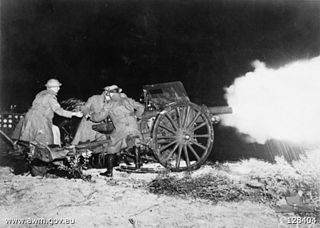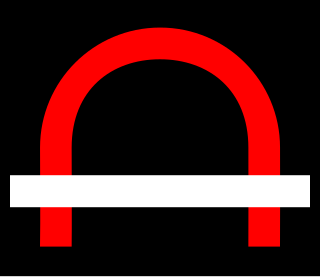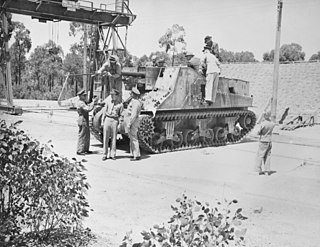The Royal Regiment of New Zealand Artillery is the artillery regiment of the New Zealand Army. It is effectively a military administrative corps, and can comprise multiple component regiments. This nomenclature stems from its heritage as an offshoot of the British Army's Royal Artillery. In its current form it was founded in 1947 with the amalgamation of the regular and volunteer corps of artillery in New Zealand. In 1958 in recognition of services rendered it was given the title the Royal Regiment of New Zealand Artillery.

The 3rd Brigade is a combined arms brigade of the Australian Army, principally made up of the 1st and 3rd Battalions of the Royal Australian Regiment. Initially raised in 1903 as part of the post-Federation Australian Army, it was removed from the order of battle in 1906 following the restructure of the field force. It was re-formed in 1914 for service during World War I, taking part in the fighting at Gallipoli and on the Western Front in Europe. During World War II the brigade was used in a defensive role before it was disbanded in 1944. It was re-raised in 1967 for service during the Vietnam War and later went on to provide the nucleus of the deployment to East Timor during the Australian-led intervention in 1999. The brigade is currently based at Lavarack Barracks in Townsville, Queensland.
The 48th Field Battery, Royal Australian Artillery was an artillery battery of the Australian Army. The battery traced its lineage back to a unit that was formed for service during the First World War. Assigned to the 9th Brigade, it was located at Keswick Barracks in South Australia until mid-2013 when it was amalgamated with the Launceston-based 16th Field Battery, to form the 6th/13th Light Battery.

The 1st Regiment, Royal Australian Artillery is a close support regiment attached to the 7th Brigade at Enoggera Barracks in Queensland. The unit was formed in 1914 under the name 1st Australian Field Artillery Brigade, part of 1st Division Artillery during World War I and later served in World War II and the Vietnam War. It is currently re-equipping with M777A2 lightweight towed howitzers.
13 Field Battery, Royal Australian Artillery was formed in New South Wales during September 1915 as the 13th Field Artillery Battery, part of 5th Field Artillery Brigade. Today 13 Field Battery is one of 4 batteries that make up the 1st Field Regiment, part of 7 Brigade.
41 Field Battery, Royal Australian Artillery was formally raised in Egypt during March 1916 for service with the 11th Field Artillery Brigade, part of 4th Division Artillery. Today 41st Field Battery is one of 4 batteries that make up the 1st Field Regiment, part of 7 Brigade.
The 4th Regiment, Royal Australian Artillery is an artillery unit of the Australian Army. Currently it provides close artillery support to the 3rd Brigade and is based at Chau Pha Lines, Lavarack Barracks in Townsville, Queensland. The regiment was raised in its current form in 1960 and is currently re-equipping with M777A2 lightweight towed howitzers. The regiment deployed during Australia's commitment to the Vietnam War and has subsequently deployed to Singapore and East Timor.

The 105th Medium Battery is a unit of the Royal Regiment of Australian Artillery that can trace its history back to March 1916, when it was raised as 105th Howitzer Battery in Egypt. The battery is based at Gallipoli Barracks, Enoggera, Queensland, as a full-time regular army unit and is one of three batteries that make up the 1st Regiment, in the 7th Brigade.

'A' Field Battery is an artillery battery of the Australian Army. The unit has been in existence since 1871, having originally been raised as part of the New South Wales colonial defence force. As part of several different larger formations, the battery has served in many conflicts including the Sudan Campaign, the Second Boer War, the First World War, the Second World War, the Malayan Emergency, Confrontation, and the Vietnam War. Today it is part of the 1st Regiment, Royal Australian Artillery, attached to the 7th Brigade based at Enoggera, Queensland. It was previously an airborne unit, but no longer maintains that role. It is currently equipped with M777 howitzers.

The 57th Division was an infantry formation of the Territorial Force created in 1914 as part of the massive expansion of the British Army during the First World War. It served on the Western Front during 1917 and 1918. The divisional number was reactivated for deception purposes during the Second World War.
The 8th/12th Regiment, Royal Australian Artillery, was formed at the Holsworthy Barracks on 16 November 1973 through the amalgamation of the 8th Medium Regiment (RAA) and the 12th Field Regiment (RAA). The Regiment provides field artillery support to the 1st Brigade based in Darwin. It is currently equipped with 155mm M777 Howitzers.
The 7th Field Regiment, Royal Australian Artillery was an Australian Army Reserve artillery unit with its headquarters at Pymble, New South Wales, and was part of 8th Brigade until it was disbanded in early 2013.
The 102nd Medium Battery was an artillery battery unit of the Royal Australian Artillery. The battery was formed in 1957, known as the 102nd Field Battery and served in the Indonesia–Malaysia confrontation and the Vietnam War before being disbanded in 1987.
The 116th Independent Field Battery, Royal Canadian Artillery is a Canadian Army Reserve independent artillery battery based in Kenora, Ontario, which forms part of the 3rd Canadian Division's 38 Canadian Brigade Group. The battery parades at the Kenora Armoury, 800-11th Avenue North, Kenora, Ontario.
The 103rd Medium Battery is an artillery battery unit of the Royal Australian Artillery. The battery was formed in 1916, known as the 103rd Field (Howitzer) Battery and served during World War I. Its successors have fought in the Indonesia–Malaysia confrontation and the Vietnam War and the battery is currently part of the 8th/12th Regiment, Royal Australian Artillery, based in Darwin, Northern Territory, as part of the 1st Brigade.

The IV Home Counties (Howitzer) Brigade, Royal Field Artillery was a new volunteer unit formed in Kent as part of the Territorial Force (TF) in 1908. It saw active service on the Western Front during World War I and was reconstituted as medium artillery in the interwar years. Later it converted to anti-aircraft artillery, in which role it served in The Blitz, North Africa and Italy during World War II and continued under various designations until its disbandment in 1969.
The 9th Regiment, Royal Australian Artillery is an artillery regiment of the Australian Army. It draws lineage from an artillery unit raised in 1903, which provided personnel to artillery units raised for service during World War I seeing action on the Western Front. It was mobilised for service during World War II and undertook defensive duties in Australia before being disbanded in 1944. The regiment was re-raised as part of the Australian Army Reserve in 2018, and currently provides artillery support to the 2nd Division. It consists of six light batteries, which are based at numerous depots around the country. The regiment's headquarters is based in Sydney, New South Wales.

The 22nd Field Regiment, Royal Australian Artillery was an artillery regiment of the Australian Army. Formed in 1916 as a howitzer brigade assigned to the 2nd Division, the unit served on the Western Front during World War I until it was disbanded in early 1917. In 1921, it was raised as a part-time unit in Victoria. It undertook defensive duties in Australia during World War II and in the late 1940s and into the mid-1950s the regiment served as a self propelled artillery unit assigned to the 2nd Armoured Brigade. It was disbanded in 1957.
The 23rd Regiment, Royal Australian Artillery was an Australian Army artillery regiment of the Australian Army. Raised in 1948 as a Citizen Military Forces anti-tank unit designated the 3rd Anti-Tank Regiment, it was converted to a field artillery regiment in the 1950s. It supported the 5th Brigade until being reduced to a battery-sized sub unit, and assigned to the 9th Regiment, Royal Australian Artillery in 2018.
The 7th Field Battery, 3rd Regiment, Royal Australian Artillery is an Reserve artillery unit of the Australian Army. Located in Western Australia, it is the artillery component of the 13th Brigade.







